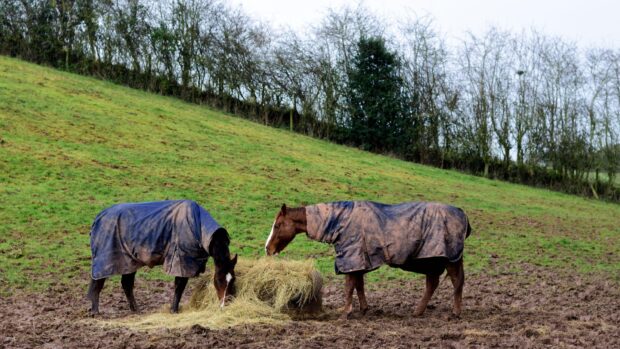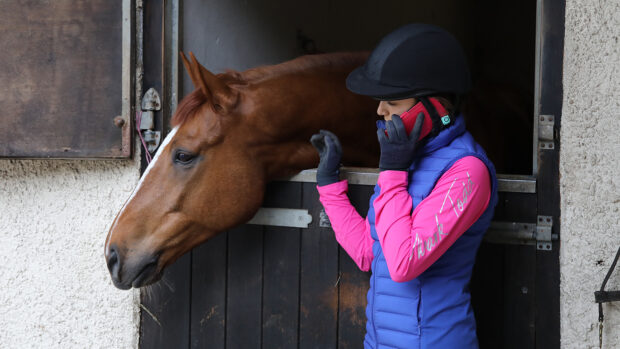Insurance may be one of the least attractive parts of horse ownership — your paperwork is likely to sit at the bottom of an increasingly large pile. But digging out your policy and rereading between the lines is time well spent, finds Hanna Lindon
When did you last have a flick through your horse insurance policy? It’s tempting to rush through the renewal process and then bury the documents at the bottom of your filing cabinet — but failure to spot problems with your insurance could leave you paying over the odds, jeopardise your chance of making a successful claim or even invalidate your policy. Here’s how to avoid the most common gaffes.
1. Non-disclosure
It’s tempting to tick the “nothing to declare” box when your insurer asks you about pre-existing conditions, but keeping shtoom could invalidate your entire policy.
Kathy Tansey, head of equine insurance at Shearwater, says that failing to inform your insurance company of illnesses or injuries your horse has previously suffered is one of the biggest blunders owners can make.
“It’s essential that you declare problems the horse has had, even if they are only minor ones,” she explains. “People think, ‘I won’t tell them and I won’t get an exclusion’, but that counts as non-disclosure and could prevent your claims from being paid in the future. The solution is to remain transparent in all communications you have with your insurer.”
2. Skimping on the research
Let’s face it, comparing a long line-up of different policies and reading thoroughly through the small print of each one isn’t how most of us would choose to spend an evening. Unfortunately, putting in the research spadework is the only way to find the perfect insurance cover.
“Many people use comparison sites, but these only compare the price of the insurance and not other crucial factors such as the excess and standard of service,” explains SEIB’s founder and chief executive Barry Fehler. “It’s important to research your insurer properly, looking into how good they are at paying claims, whether they are UK-based, whether the staff are knowledgeable about horses and how long they have been established.”
3. Buying first, insuring later
In the market for a new horse? Guy Prest, managing director at KBIS, recommends contacting an insurance company before even arranging the vetting.
“The most frequent problem we see is when a horse is vetted and purchased before checking out if it is fully insurable,” he says. “Ask your intended insurer what documentation (such as a vetting or x-rays) is required. Once vetted, send the certificate and x-rays (when taken) to your insurer to review (there may be a charge for this which will generally be deducted from the policy premium) and see if they are going to place any exclusions on the policy. This may stop you buying the horse, or you could accept that a specific risk is excluded from the policy.”
He also emphasises the importance of insuring the horse at purchase — not days or even weeks later, when the vet’s certificate will be out of date.
“This is important because if you have purchased a horse within seven days and vetted it within 14 days of inception of the policy, at KBIS, your policy will have no limitation period meaning you are fully insured straight away (this applies to KBIS leisure and competition horse policies). If you are not vetting your horse, it is still worth purchasing cover as soon as money changes hands as then you can get your limitation period over as soon as possible and your horse will still be covered for any accidental external injuries. It is also worth noting that cover for public liability and personal accident kicks in with all policies straight away.”
4. Forgetting to update your policy
It is extremely important that you notify your insurer of any changes to your information. If you do not update insurers you could find that in the event of a claim it could be declined. You could also find that your policy is invalidated if material facts have been withheld from insurers either at the inception of the policy or at renewal. When an insurer issues a policy or offers renewal terms they are doing so based on the information you have told them and therefore in good faith.
5. Doubling up on insurance
Insuring yourself twice for the same activity can cause almost as many problems as not insuring at all. There are two areas where this is a particular issue: public liability, and tack insurance.
“People tend to put public liability on their horse insurance, but if you’re a member of an organisation such as British Dressage then you should already be covered,” says Kathy.
“Similarly, if you keep your tack at home, it will probably be covered by your home insurance. Double insurance will up your premium and cause potential issues when you make a claim.”
While doubling up isn’t illegal or invalidating, it can cause a claim to be delayed while the insurers sort out who’s paying what — and it’s a waste of money.
6. Not insuring for the right activity
Moving up the ranks within your sport or dabbling in a new discipline? You need to look at updating your insurance policy.
“Insurers rate each riding activity based on their view of the risk factors, for example prelim dressage is likely to be classified as a lower risk than novice eventing,” says Guy. “In principle, the higher the risk of claims the more the premium.”
He adds that it’s essential to make sure that your policy reflects the activities you currently take part in.
7. Overvaluing your horse
Most horse insurers offer market value policies. That means you’ll receive the market price for your horse in the event of loss of use or death, regardless of how much you’ve insured it for.
Something that’s all too common with equine insurance is owners often overvalue their horses. It’s similar to thinking about how a car often depreciates in value the older it gets,” says Francis Martin, CEO of The Insurance Emporium. “Successful claims for ‘death, theft or straying’ will either be paid 100% of the sum insured or its market value, whichever is less, and this is what confuses owners.”
“While you may have paid £12,000 when you bought your horse at four years of age, it doesn’t mean two years on it is still worth that much. Furthermore, you could be paying a higher premium on your insurance if you continue to value the horse above its market value.”
“You might have paid £15,000 for a horse as a five-year-old and continued to insure it for that amount, even though its value has decreased,” says Kathy Tansey.
“That means you’re paying the premium for a £15,000 horse. However, in the event of a claim you would only receive the reduced amount that is its market value. It’s important to be realistic and to keep your policy updated with the horse’s current worth.”
According to Kathy it doesn’t work both ways, so if you paid £5,000 for a horse that is now worth much more than this then it’s important to increase its value on your insurance policy.
8. Ignoring the small print
Few of us slog through the reams of terms and conditions that accompany insurance policies, but it’s important to be clear about exactly what you’re signing up for. Insurers have a responsibility to provide information regarding the policy terms and conditions in a clear, fair and unmisleading way. While you may not feel inclined to read the whole policy document, the policy summary is an essential read. You should do so as soon as you buy the policy because if you don’t like what you read you are entitled to cancel the policy within 14 days and get your money back if you haven’t made a claim — although there may be an administration fee for this.
Customer service departments are there to help, but in the end it’s down to you to be aware of the appropriate level of protection you require. Time to get that magnifying glass out…
9. Not insuring at all
The largest and most obvious insurance blunder is the failure to take out cover altogether. Forget to renew your policy, and you could find yourself left with vet bills amounting to thousands of pounds.
“Especially with the ongoing cost-of-living crisis it can be tempting to self-insure with a view of saving money however, it’s not without its risks,” says Francis Martin, CEO of The Insurance Emporium. “Having equine insurance tailored to your needs doesn’t have to cost the earth and on the flip side, could save you thousands of pounds should the unexpected happen.”
“Allowing for insurance in your budget is important as veterinary fees can quickly add up if your horse is unwell says Kate Hopkins, Petplan Equine marketing consultant. “Without insurance, you would not be able to provide the level of care needed to treat your horse and look after him during recovery.”
“Petplan Equine’s statistics for the most claimed for conditions in 2019 showed an overall rise in claims which highlights just how crucial insurance is when caring for your horse,” comments Kate.
“In 2019 arthritis returned to the top of the list for the first time in three years with veterinary fees paid out totalling over £847,000, an increase of over 8% when compared to 2018. Although dropping from first to second place, gastric ulcer claims remained consistent with a small increase in the value of claims paid out compared to 2018, just under £1.1 million.”
“These figures show how important it is to have quality horse insurance should the worst happen and your horse requires unexpected veterinary treatment. We know how much our customers love their horses and treat them like a member of the family, so we are always here to reassure and support them whenever we are needed.”
You may also be interest in…

Equine insurance: choosing the right policy
Insuring your horse can be a confusing and time consuming process, so follow our top tips to choose the best

Subscribe to Horse & Hound magazine today – and enjoy unlimited website access all year round
Horse & Hound magazine, out every Thursday, is packed with all the latest news and reports, as well as interviews, specials, nostalgia, vet and training advice. Find how you can enjoy the magazine delivered to your door every week, plus options to upgrade your subscription to access our online service that brings you breaking news and reports as well as other benefits.



